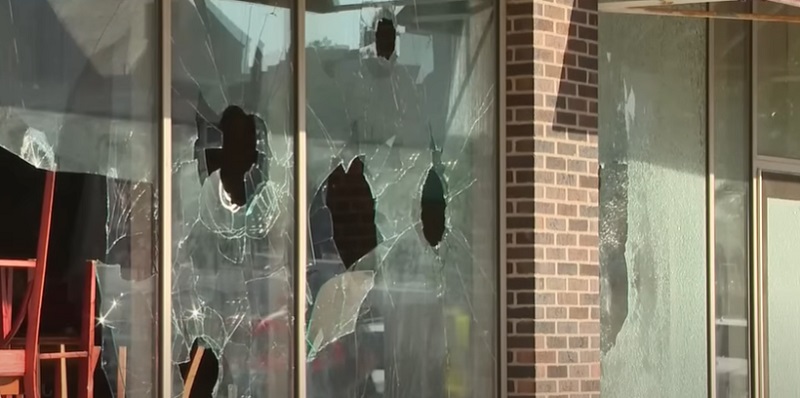
I know we aren’t supposed to call names or label, but sometimes the shoe just fits too well to ignore. The protests of the use of lethal force against 25-year-old Jayland Walker in Akron, Ohio have tipped from reasonable concern developed after the event for lack of facts to outrageous and malicious violence victimizing innocent residents and business owners.
Within less than 60 seconds after Akron police attempted to stop Walker for traffic and vehicle equipment violations, gunfire came from Walker’s vehicle. What appears to be a muzzle flash was captured on a traffic camera, and the sound of a gunshot is heard on an officer’s body-worn camera. With an armed and fleeing suspect, police engaged in a pursuit of the car. After several minutes, Walker slowed the vehicle, and he got out and ran. Officers pursued him on foot and attempted the use of a Taser to stop him. Walker suddenly turned toward the officers and they believed he made a move consistent with drawing a weapon. Several officers fired.
Let’s look at the critic’s arguments. Many will say that police should not be stopping vehicles for minor traffic violations. We can agree that examining traffic stop patterns for racial bias and ticketing to raise municipal revenue are reasonable accountability audits. But to say that broken taillights, speeding, not using turn signals, and expired license plates, etc should be left alone is to ignore some very real consequences of non-enforcement. The same violators that we curse for causing our near-collisions are the ones we hope were seen by the police, but who the critics think should be left alone.
One of those consequences is more traffic deaths and injuries. While violent crime seizes headlines, the carnage and cost of traffic crashes are also increasing. Navigating in traffic is a complex effort despite our comfort level with it. We rely on obedience to traffic laws and vehicle equipment and licensing regulations to ensure the generally safe travel of ourselves, our loved ones, and our commodities. Those of us who have driven in third-world countries in the absence of these commonly accepted rules of the road can testify to the degradation of safety suffered where laws may not exist or may go unenforced.
Another consequence of fewer traffic contacts is that drunk drivers and armed offenders like Walker can travel about endangering the public with little fear of consequences.
As always, the critics wonder why the situation wasn’t de-escalated. This is one area where ignorance often meets stupidity. Drivers are required by law to stop and comply with the police, not speed away and fire gunshots. Citizens are required to comply with lawful arrests rather than run. They cannot expect officers to open their arms for a hug when an offender runs toward them and makes threatening gestures. Those who flee and see that a Taser has been deployed should reasonably understand that the officers are giving them a chance to submit without being faced with deadly force. The timeline of Walker’s actions and the officers’ responses are measured out in seconds with no discernable room for anything other than what the officers did to protect the public from Walker’s behavior. To the question of why didn’t the officers de-escalate, the response is that they did.
Another critique in this case is what appears to be an excessive number of shots fired by police. We can understand the questions that civilians have about why there are so many wounds. First, if deadly force is legally and ethically appropriate, as appears in this case, then the means and extent of its delivery is a moot point. We are conditioned to the fair fights of TV and movies and naturally recoil at what reality reveals. Walker’s autopsy results may or may not reveal which of the wounds inflicted were from bullet entry, bullet exits, or bullet fragments. The initial reports of 60 wounds don’t mean that 60 shots were fired.
Police officers must make their own, independent decisions to fire their weapons or not. When multiple officers are present, as would be expected in this case after a pursuit and reports of shots fired, each makes their own determination based on their point of view and observations. Critics will say that after one officer fires, the others join in as a result of a contagion effect. Indeed, the fact that one officer saw a deadly threat and fired is one of many considerations that other officers at the scene may use, but they know that they will have to justify every trigger pull from their own judgment.
Finally, police officers are often trained to fire more than once after determining there is a deadly threat. Once again, the entertainment industry has injected toxic distortions about the reality of the effects of bullets on the human body. The reality that many offenders are using body armor gives rise to purposeful multiple shots beyond the center mass (shooting to the center of the torso) exercises that officers practice on the target range. Advancing aggressors have shown a remarkable ability to continue their attacks when wounded. Therefore, it is not unreasonable for an officer to fire two to five rounds at a threat to end it.
Finally, the argument that Walker was unarmed when shot is a distraction from reality. Officers, who are trained humans but humans still, had knowledge that he had been armed, that he was actively resisting efforts to apprehend him to end his dangerous behavior, and turned to charge what he knew was a phalanx of armed police while displaying behavior inconsistent with merely running but, rather, behavior consistent with drawing a weapon.
The outraged want the eight officers fired and jailed, the police department reviewed, training changed, and probably have Chief Stephen Mylett tarred and feathered. The sole person responsible has already been held accountable for the whole affair: Jayland Walker. Weep for him if you will, but burning buildings and hating the police over his death is without excuse.